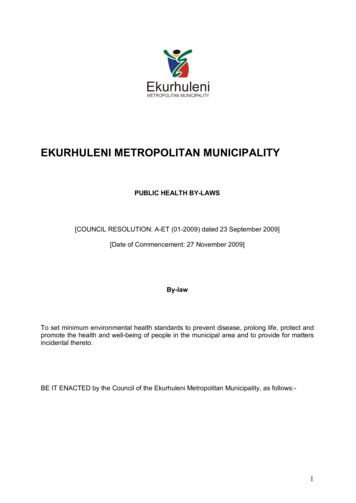
Transcription
Guide togoing publicStrategic considerationsbefore, during and post-IPO
ContentsGoing publicSituations, cases and motivations3Pros and cons of going public6IPO success factors and challenges7 IPO process and EY’s IPO value journey9IPO value journey Phase 1: Strategic considerations and IPO planning11 Phase 2: IPO preparation26 Phase 3: IPO transaction34 Phase 4: Being public4212–24 months before IPO6–12 months before IPO1–6 months before IPOPost-IPOEY — with you all the wayContacts1 Guide to going public4850
ForewordFor private companies seeking to raise capital andprovide exits for their shareholders, an initial publicoffering (IPO) can be a superior route and strategicoption to funding growth and to access deep pools ofliquidity. While challenging markets will come and go,it’s the companies that are fully prepared that willbest be able to create value and fully leverage theIPO windows of opportunity whenever they are open.The companies thatare fully prepared will beable to create value andfully leverage the IPOwindows of opportunity.Companies that have completed asuccessful IPO know the processinvolves the complete transformationof the people, processes and cultureof the organization from a privateenterprise to a public one. Preparationis critical. Successful IPO candidatesoften spend two years or morebuilding business processes andinfrastructure, recruiting executiveand advisory talent, getting in frontof financial and reporting issues andmastering the essential board ofdirectors’ commitment to go public. During the journey to become a publiccompany, an organization must prepare not only for the defining momentof the IPO ceremony, the ringing of the bell, but also for a whole new phaseof corporate life after the IPO takes place. That’s why market outperformerstreat the IPO as a long-term transformational process.EY is a key member of your external IPO team. We have worked withbusiness owners and management teams of family businesses, scaledup and high-growth companies as well as private equity- or venture2 Guide to going publiccapital-held companies considering their strategic options for funding forgrowth, including a public listing. We have professionals with extensive,proven experience with domestic and international capital markets. Ourprofessionals have deep knowledge of your industry, which allows us tocreate interdisciplinary teams that will steer you onward, through andbeyond your IPO and support your plans for growth.We are confident this Guide to going public will give you an initial overviewand checklists of the key phases in going public from a global perspective.It is based on EY insights from many IPO transactions, to help you beginyour IPO value journey, so that you are well prepared to transform yourprivate company into a successful public company that continually deliversvalue to its shareholders. With more than 30 years’ experience helpingcompanies prepare, grow and adapt to life as a public entity, we are wellsuited to take you on your IPO journey providing tailored support andintegrated services before, during and after your IPO.Our IPO leaders in your region and our global network will serve you fromevaluating strategic options pre-IPO to setting you on the right path tosupport growth post-IPO, while anticipating the expectations of variousparties — including regulatory boards, the financial community, the pressand investors — along the way.Irrespective of your market or region, we look forward to exploring with youthe various strategic options and each facet of your IPO value journey.EY IPO Leaders
Going publicWhat to do when yousee an IPO on the horizon.Situations, cases and motivationsWhy would you conduct an IPO?An IPO is the first sale of a company’s shares to thepublic and the listing of shares on a stock exchange.It allows a company to raise capital in order to build itsbusiness by creating newly issued shares and sellingexisting shares.There are many situations when companies start to evaluate an IPOas one of their strategic options. Funding or exit motivations, growth,internationalization and changes in the respective industry aretriggers for strategic considerations around an IPO. Depending on thestakeholder, a mix of situations and motivations can lead to initial IPOconsiderations.3 Guide to going public
Going publicTypical contexts for companies that go publicTypical IPO case studies are: High-growth companies: IPO to fund innovation, growth, acquisitionsand internationalization Private equity (PE) and venture capital (VC) owners: IPO as a way toexit and to further fund growth of portfolio companies Family business — the company: IPO as integral part of the successionplan and to separate management and ownership Family business — the owner: IPO to diversify wealth and to bettermanage succession Scale-up companies: IPO as a way to better attract talent and toincentivize management Conglomerates: IPO as a transaction to carve out and partial or fullexit of business units State-owned entities: IPO to privatizeFigure 1: Typical contexts for companies that go publicStrong companygrowthPE/VC: e xitpressure and maturityConsolidation trendsIPO o f competitorsCompanysituationFirst mover and innovatorNextgeneration/ successor4 Guide to going publicFront runner andindustry disruptorNew openness and publicawareness
Going publicTypical motivations for going publicFor many companies that have just started to consider going public, thekey question is: could an IPO be the right next step?The preparation starts with the careful evaluation of pros and cons of anIPO, the potential use of proceeds and examination of alternatives. Thisis in line with the first questions from investors at an IPO road show: whyare you going public and what is the use of IPO proceeds? Answeringthese fundamental questions is key to the success of an IPO.A successful listing can help your company unlock access to financingto complete a strategic acquisition, create opportunities to expand yourbusiness into new markets or provide an exit opportunity for your privateequity or other investors. In addition, it can also improve perceptions ofyour business and brand with customers, suppliers and employees.While not all businesses are suited for life in the public eye, for manyfast-growing private companies, an IPO can raise the capital needed toaccelerate growth and achieve market leadership.Figure 2: Typical motivations for going publicIncreased b randawarenessImproved standing/ credit- worthinessImproved appeal as an employerPartial exit f orcurrent o wnersIPO“ The best reason to go public isn’t to exit.It isn’t to get the going-public experience.It’s because it’s the right step in the pathon which you’re guiding your company.”Separation o fmanagementand capitalStrengthen equityCo-founder of a pharmaceutical companyNew growthand valuation potential5 Guide to going publicAcquisition currency
Going publicPros and cons of going publicOutperforming companies weigh the benefits of goingpublic against the drawbacks, as well as against thecompany and shareholders’ objectives.The possible advantages of going public as shown in Figure 3 arenumerous, including improved financial condition; gaining liquid M&Acurrency; increased capital to sustain growth and innovation; betterincentives for management and employees through stock options;enhanced corporate image; better future financing opportunities; andthe ability to benchmark operations against other public companies fromthe same industry.The potential drawbacks of going public can include holding a lowerstake in the company and loss of privacy; limits on management’sfreedom to act; the demands of periodic reporting; initial and ongoingexpenses; the burden of dealing with shareholders’ expectations; andincreased disclosure requirements.Figure 3: Pros and cons of going publicPros Efficient access to capital markets to raise money throughequity and bond offerings Flexibility to trade shares with high liquidity and dailyvaluation Greater attention, better brand recognition and prestigewith consumers Shares functioning as new liquid M&A currency Potential to diversify wealth on shareholder side Enhanced ability to attract, retain and reward valuedemployees as listed company Opportunity to bond and incentivize key people withlong-term incentive plans6 Guide to going publicCons Time-consuming tasks, particularly investor relations Greater transparency and disclosure requirements Total IPO flotation costs Add-on costs associated with the ongoing requirementsas listed company New investors with voting rights Pressure to deliver on your promises Corporate governance duties
Going publicIPO success factors and challengesWhat are the critical IPO success factors forinstitutional investors?Investors will decide whether they buy shares of your IPO or not. Thisis why we recommend that you view your IPO from an institutionalinvestor’s perspective. Institutional investors drive stock prices andinclude mutual funds, hedge funds, banks, insurance companies,pension funds, larger corporate issuers and other corporate financeintermediaries.Based on our experience the most important IPO success factors toinvestors are:1. Strong management team2. Compelling equity story3. Fair pricing4. Right timing5. Be “IPO ready” to meet capital market requirementsand investor expectations7 Guide to going public
Going publicWhat are the success factors in getting IPO ready?We have found that companies with successful IPOs:Outperform competitors on key benchmarksEvaluate capital-raising options Investors base their IPO investment decisions on financial factors,especially debt to equity ratios, EPS growth, sales growth, ROE,profitability and EBITDA growth. Start early with a holistic discussion about the strategic optionsoffered by IPO and M&A markets and consider an array of exit andfunding alternatives in an IPO readiness assessment. Consider a multitrack approach and the expanding number of capitalraising strategies — including IPO, a strategic sale to a strategic buyeror financial investor (PE/VC). Preserve optionality with early IPO readiness preparations to get IPOready, to achieve flexibility in timing and pricing and to prepare formore narrow IPO windows.Prepare early Approach the IPO as a transformational process rather than just afinancing event; begin with a holistic IPO readiness assessment as afirst step ideally in a 12–24 months period. Begin the IPO readiness process early enough so that your pre-listedcompany acts and operates like a public company at least a yearbefore the IPO. Assemble the right team of external advisors and commit substantialinternal resources to the IPO team and process. Build a qualitymanagement team, robust financial and business infrastructure,corporate governance and investor relations (IR) strategy that willattract the right investors.8 Guide to going public Investors base an average of 40% of their IPO investment decisionson non-financial factors, especially quality of management, corporatestrategy and execution, brand strength and operational effectiveness,and corporate governance. Be able to articulate a compelling equity story backed up by a strongtrack record of growth that sets your company apart from your peerswhile maximizing value for owners.Address investors’ current concerns Recognize the need for enhanced corporate governance, especiallyrecruiting qualified non-executive board members, improving internalcontrols and forming a qualified audit committee. Fine-tune your internal business operations, especially working capitalmanagement, regulatory risk and rationalizing the business structure. Deal with current accounting challenges, especially segment reportingand accounting changes.
Going publicIPO process and EY’s IPO value journeyThe IPO process should be a structured and managedtransformation of the people, processes and culture ofan organization.At EY, we refer to this as the IPO value journey, which embraces thephilosophy that the IPO event is not the end game but a momentousoccasion that will impact your organization long after the actualtransaction. The value journey typically begins at least 12 to 24 monthsbefore the IPO and continues well beyond it. Thus, while an IPO shouldbe a key turning point in the life of your company, market leaders don’ttreat an IPO as simply a one-time financial transaction. Rather, theyrecognize the IPO event itself as just one defining milestone in a complextransformation from a private to a public company.Even when the financial climate is not ideal for raising funding, it couldbe a good time to be planning and preparing for an IPO or any otherstrategic transaction. While waiting for markets to settle, executives canembark upon the IPO value journey. Those companies that undergo aneffective IPO readiness transformation during uncertain times will bebest positioned to take advantage of improved equity market conditions.In the life-changing journey from the private realm to the public markets,you will face numerous leadership challenges. It is up to the CEO andsenior executives to strike the right balance between executing the IPOtransaction and managing the day-to-day operations of the company.Rather than just asking if the markets are ready for you, the key questionthat you will need to ask when entering the public markets is:“Are we prepared to deliver?”This IPO value journey describes the top 16 steps — from the goingpublic stages to the being public stage. Starting with the early strategicconsiderations and IPO planning phase, to the IPO preparation phaseand on to the IPO transaction and post-IPO phases.9 Guide to going public
Going publicIPOFigure 4: EY’s IPO value journey: four phases in a typical IPOIPO preparationStrategic considerationsand IPO planning1234567812–24 months prior to IPO6–12 months prior to IPO1. Evaluate strategic options andperform a health check, ideallyan IPO readiness assessmentand diagnostic.2. Decide on the preferred option,a Plan B and set up resourcesand your IPO projectmanagement office.3. Prepare group systems,new functions and taxoptimization at the company and shareholder levels.4. Start to build capital marketinfrastructures and/or makestructural adjustments toachieve IPO readiness.5. Fine-tune the business plan andIPO fact book, and preparepresentation materials forbanks, analysts and investors.6. Build the right external IPOteam (bankers, lawyers,auditors, investor relations andother advisors).7. Set the target IPO timetable,start due diligence, andprepare the offering concept.8. Fine-tune the equity story andvaluation framework based oninitial feedback from investors.10 Guide to going publicIPO transaction91011121–6 months prior to IPO9. Prepare financial informationand other important content forthe first draft of the offeringprospectus.10. Manage the filing process,finalize prospectus and seekapprovals from the regulatorand the stock exchange.11. Launch the investor roadshow, to attract the rightinvestors in main pools ofcapital with the rightmarket timing.12. Build the IPO order book,determine the issue price andallocate orders to investors.Being public13141516Post-IPO13. Enjoy the IPO ceremony anddeliver on your promises as a public company that attractsmore media attention.14. Mobilize investor relations,road shows and investormarketing based on theIR calendar.15. Manage investor expectationswith efficient forecasting andthe use IPO proceeds.16. Deliver high-quality externalreporting and disclosures, andgood corporate governance.
Phase 1:Strategic considerationsand IPO planning12–24 months before IPOThe questions that shouldbe on your radar whenit comes to strategy andIPO planning.11 Guide to going public
IPO value journeyPhase 1: Strategic consideration and IPO planningIPOStrategic considerationsand IPO planning123412–24 months prior to IPOIPO preparation56786–12 months prior to IPOIPO transaction910 11121–6 months prior to IPOBeing public13141516Post-IPO1Evaluate strategic options and perform a health check, ideally an IPO readiness assessmentand diagnostic.2 Decide on the preferred option, a Plan B and set up resources and your IPO project management office.3 Prepare group systems, new functions and tax optimization at the company and shareholder levels.4Start to build capital market infrastructures and/or make structural adjustments to achieveIPO readiness.12 Guide to going public
IPO value journeyIPO readiness stepPhase 1: Strategic consideration and IPO planning1Evaluate strategic options and perform a health check, ideally an IPO readiness assessment and diagnosticStrategic optionsHave you evaluated other attractive alternatives and are you surean IPO is the right strategy?Figure 5: Pros and cons for issuers of different funding or exit routesGoing public is not for everyone. The potential pitfalls are numerous andthe stakes are high.MarketFunding and/orexit routeWhile an IPO may be your favored approach to raising capital, it’simportant to evaluate all possible transactions that could serve asstepping stones or attractive alternatives to a public listing in the contextof shareholder and corporate objectives.PrivateSale to PE or VC Speed of transaction and one-off transaction Greater privacy both pre- and post-deal Greater confidentiality regarding deal valueand liabilities Future exit by PE (five to seven years) Codetermination and/or voice in decisions Reporting requirements of PE/VC investorsSale to a corporate Speed of transaction and one-go transaction Greater privacy both pre- and post-deal New growth opportunities from being part of abigger group Full liquidity at event Loss of exclusivity and entrepreneurialfreedom Change of management power Uncertainty about medium-term strategySale to a family office Shared values and long-term perspective Continuity in decision-making fromowner to owner Smoother transition Loss of influence and power Not continuing the family legacyIPO More entrepreneurial independence is retainedcompared with a private market exit Access to and leverage of new sources of capital Daily price determination (valuation on adaily basis) Liquid currency for acquisitions andcompensation Regulatory burdens and strict transparencyrequirements Unpredictability of markets andIPO windows Limited near-term liquidity (for remainingshareholders with further exit intentions)Your alternatives may include any combination of the following: Sale to a strategic buyer through the M&A market Sale to a private equity (PE) or venture capital (VC) firm Sale to a family office Private placement, often as a pre-IPO stepGiven the range of potential alternative transactions, you need to havea clear idea of what’s involved, how long the process will take, what it’slikely to cost and whether two or more routes need to be run in parallel.Public13 Guide to going publicProsCons
IPO value journeyPhase 1: Strategic consideration and IPO planningEY’s IPO readiness assessment —getting IPO readyHave you considered a sale to a strategic or financial buyer?The relative attractions of a sale will vary, especially depending onwhether it is a strategic or financial buyer. A sale to a trade acquirer orfinancial buyer (e.g., PE) is often considered as an alternative to an IPO —depending on the objectives of existing stakeholders and managementand the attributes of the business. For instance, a PE buyer can providean alternative for growth companies that may not be operationally readyto access the public capital markets. Not all companies will be attractiveto financial buyers and the population of potential strategic acquirersmay be restricted for some companies. A detailed evaluation of thesuitability and viability of M&A, as an alternative to IPO, should alwaysform part of the process of determining whether to pursue an IPO.Who is likely to buy the business and what do buyers/investors focuson in a prospect?Understanding the needs of the buyer is crucial for a successfuldivestment process. Usually, buyers focus on sales and revenue trending;underlying cost base; working capital management; and business planstrength. While all buyers are concerned about key value drivers such asmarket share, competition, growth potential, the stability of cash flows,the cost base and the quality of underlying assets — different purchasershave different strategic concerns.The appropriate exit strategy will differ significantly based on the likelybuyer, yet it should contain contingency plans should a different type ofbuyer emerge during the divestment process.Have you evaluated which pre-IPO transactions could enhancean offering’s value?Your company’s overall transaction strategy should be made up of much morethan the IPO itself. Most companies undertake pre-IPO strategic transactions,which are powerful tools for accelerating the development of your business.In challenging market conditions, it may be more difficult to obtain pre-IPOtransactions and to close the deal. Nonetheless, most successful companiestypically do undertake transactions in advance of the IPO.A successful business alliance or M&A can help you achieve critical massand also support your growth story. If a company can demonstrate thata successful joint venture partnership or acquisition has already beencompleted and integrated, it adds credibility to a company’s growthplans. Investors may be more skeptical of IPO candidates that have notdemonstrated successful pre-IPO transactions where an acquisition strategyforms part of the post-IPO growth story.The possible benefits of pre-IPO transactions: Facilitate growth, such as expanding into new markets Strengthen the business Increase company revenues Offer scale to the listing Provide a platform for operations, management and financial reporting Increase credibility with market analysts and investorsAre you prepared?Once you decided to go public, you will need to map out all the necessarysteps. Advance preparation and planning are critical. Unpredictable IPOmarkets make dual-tracking, IPO readiness and internal preparationmore important than ever. Be ready to kick-start execution when the IPOwindow of opportunity opens. Getting IPO ready in the correct way meansimplementing change throughout the business, organization and thecorporate culture. As a public company, you will be subject to increasedfiling requirements, transparency, compliance, scrutiny by investors andanalysts, and overall accountability for delivering on promises.To start the IPO planning and preparation process “on the right foot,” EY’sIPO readiness assessment is a structured approach designed to guide thecompany through a successful IPO transaction to a strong debut in the IPOmarket. Successful businesses start to prepare 12 to 24 months beforethe IPO — in many cases with an IPO readiness assessment.What are the objectives and values of EY’s IPO readinessassessment?It is designed to guide your company through a successfultransformation from private to public status. Executives also want tounderstand more of the “measures that matter” — what it takes to win inthe capital markets. Typical objectives are:1. Define an IPO base case that would become importantinformation for the assessment2. Identify the IPO readiness gaps and assess the efforts requiredto get ready3. Train the key people on IPO leading practices and regulatoryrequirements4. Prioritize the gaps in an IPO road map14 Guide to going public
IPO value journeyPhase 1: Strategic consideration and IPO planningFigure 6: EY’s integrated assessment and program managementof IPO readiness1Strategy IPO venueand exchange Equity story Issue concept82 Issuing company Group structure Governance a nd legalTimelineLeadership C-suite Board of directors Remuneration andhuman resources15 Guide to going public3IPO readinessassessmentand programmanagement6Functions Investor relations Compliance officer CommitteesTaxes Company level Shareholder level Transaction level4 IPO timelineand regulatoryapproval Plan B options Project managementand resources7StructuresFinancial External reporting Business plan andforecasting Prospectus5Systems Internal controlsand audit Enterprise risk Compliance and ITPerceived values of conducting an IPO readiness assessment include:What is the scope and process of EY’s IPO readiness assessment? Saves costs by having transparency on how to get IPO readyIn an integrated approach, the assessment helps owners and managersmap out what organizational changes are needed prior to an offering.Our IPO readiness assessment is a three-step process and typicallystarts with an IPO readiness assessment workshop. Our assessmentcovers all areas specific to the IPO case: strategy, structures, taxes,financials, internal systems, functions, leadership and the plannedtimeline. We work hand in hand with you to identify and discuss any gapsthat need closing on your IPO value journey. We also discuss strategicfunding considerations and develop an initial target structure and IPObase case in line with your objectives. EY’s IPO readiness assessmentcan include up to eight modules tailored to your specific needs(see Figure 6). Saves time getting valuable insights in IPO leading practicesAn IPO readiness assessment helps decide which options best fit yourbusiness strategies and objectives, delivers an IPO base case andbuilds the road map for getting IPO ready. Raises transaction certainty in unpredictable IPO marketsThe right team, right story, right timing and right pricing are pivotal tosuccess. EY views every IPO as transformational — it should occur overtime in a structured way that maximises transaction value; this is animportant step in the life cycle of the entrepreneurial businesses weserve. Achieving readiness will provide flexibility in timing, and helpensure a strong debut in the capital markets.We compare the target structure with the current structure to revealany gaps. We analyze these in greater detail in individual follow-upworkshops and clarify the time, content and resources required to closethem. These results are then used to develop the plan for the workleading up to the multitrack option/IPO.EY’s IPO readiness result report defines the strategy that lays thefoundation for further discussions and multitrack readiness checkpoints,it presents the gaps between your current status and IPO targetready status, and recommends work streams and a road map. It alsoestimates timelines and resources required to fill the gaps and achieveIPO readiness.
IPO value journeyPhase 1: Strategic consideration and IPO planningEY’s IPO destination assessment — finding the right spotHave you chosen the right stock exchange and listing option?Selecting the right capital market, stock exchange and listingsegment enables you to determine the regulatory requirements thatyour company will have to meet. In the run-up to going public, yourcompany’s internal structures have to be checked and prepared forthe relevant requirements. These measures are essential to maintainthe profile of a listed company and meet the requirements of investorsand regulators. The first key steps in this phase involve determiningthe appropriate capital market strategy and achieving internal capitalmarket capability.EY’s Global IPO trends report shows that on a long-term average morethan 90% of issuers list on their domestic stock exchanges, althoughthey may sell shares abroad simultaneously.Where to list? Capital market venue, stock exchange and listingsegment — what’s the best option?Companies can choose from more than a hundred stock exchanges andlisting options worldwide. Besides listing in your home market, there arethree self-contained regional venues for companies wishing to go publicoutside of your home market, namely, in Americas, Asia-Pacific andEMEIA. Each venue is distinguished by its time zones, culture, currenciesand economies.Questions to consider are: Does it make sense to go public and haveyour primary listing in your company’s country of incorporation? Orshould you look further afield? Finding the answers to these questionscan pose complex challenges — particularly if there are strategicbenefits to listing your company far from its familiar national market.For example, you can expect a listing abroad to attract consumers’attention to your company’s products and media presence. This canfacilitate access to new markets and benefit your business operations.EY’s IPO destination compass provides guidance in the factors thatrequire careful examination. Our IPO destination assessment supportsa structured way to assess these factors, presented from differentIPO stakeholder perspectives. Arguments why to list abroad can becategorized in four areas: Motivations and goals of your strategy Factors that are relevant to valuation Shareholder preferences Initial and ongoing costs16 Guide to going public
IPO value journeyPhase 1: Strategic consideration and IPO planningsstTotal flotationand ongoingpost-IPO costsStrCapital marketsregulationsyegatCoFigure 7: EY’s IPO destination compass: considerations when deciding where to listStrategic fit: Consumers Growth marketsInitial and ongoing stockexchange requirementsLegal andand marketmarketrisksrisksSpeed of approval processCurrency: M&A target market Financing growthLiquidity on thestock exchangeIPOLanguageand cultureAvailability ofanalyst expertise17 Guide to going publiccesParticipationin indicesValuation level ofcomparable companiesPeer companiestionerefPrenBrand recognitionpotentialInvestor base andattentionluaPrestige andcritical mass ofthe marketplaceVa
IPO value journeyIPO readiness stepPhase 1: Strategic consideration and IPO planning2Decide on the preferred option, a Plan B and set up resources and your IPO project management officeStrategyDo you have an alternat
The IPO process should be a structured and managed transformation of the people, processes and culture of an organization. At EY, we refer to this as the IPO value journey, which embraces the philosophy that the IPO event is not the end game but a momentous occasion that will impact your organization long after the actual transaction.











